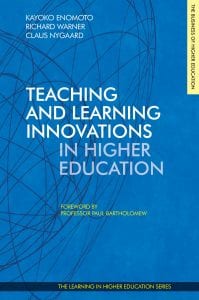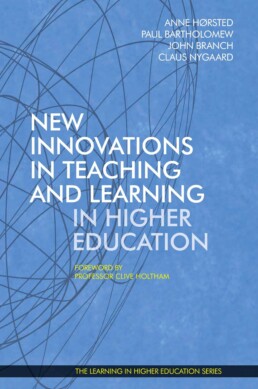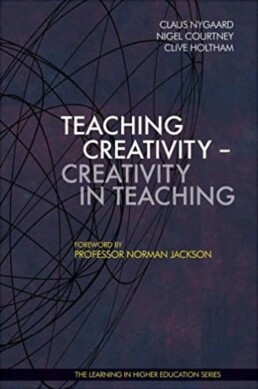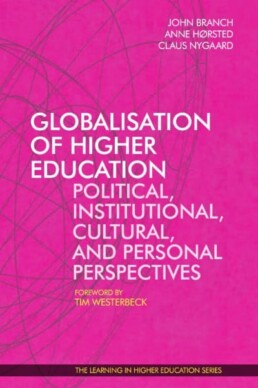Description
Teaching and Learning Innovations in Higher Education
Teaching and Learning Innovations in Higher Education showcases transformative, theory-informed innovations in higher education teaching and learning.
It presents a brand new, unique perspective on innovation in Higher Education – the Learning-centred Five-tier Model of Innovation – which guides educators in their innovation of teaching and learning products, processes, or services. A distinguishing feature is a linkage to the Five-tier Model of Innovation that explicitly relates to three learning paradigms: 1) instructivism, 2) cognitivism and 3) constructivism. In each chapter, the authors situate their teaching and learning innovations in one of the three learning paradigms.
The book holds 21 inspiring cases showing learning-centred product-, process-, or service innovations within five focus areas:
- Learning Space Design;
- e-learning;
- Case-Methodology, Business Practice and Fieldwork;
- Creative Methodologies; and
- Reflective Methodologies.
We selected the book’s cases because of their novel methodologies, explicit learning perspectives, and positive effects on student learning and student engagement.
The book features diverse disciplines in a wide range of international contexts, with authors from Australia, Canada, Denmark, England, Finland, Italy, Japan, New Zealand, Singapore, Turkey, Vietnam, and the USA.
About the Editors
Kayoko Enomoto is Senior Lecturer, Head of Asian Studies and Director, Student Experience in the Faculty of Arts at the University of Adelaide, Australia.
Richard Warner is a Lecturer in the School of Education in the Faculty of Arts at the University of Adelaide, Australia.
Claus Nygaard is Executive Director and Professor at Institute for Learning in Higher Education, Denmark; Adjunct Professor at Copenhagen Business School, Denmark; Adjunct Professor at the University of Aarhus Denmark; Visiting Professor at Stockholm School of Economics Riga, Latvia. Expert in Management Education and learning-centred higher education.

Pages: 506
Published: 2021
ISBN: 9781911450733
Publisher: Libri Publishing Ltd.
Overview of the Book
Foreword. By Paul Bartholomew (pp. ix-xii).
Chapter 1: What Drives Teaching and Learning Innovations in Higher Education? By Kayoko Enomoto, Richard Warner and Claus Nygaard (pp. 1-18).
Chapter 2: A Learning-centred, Five-tier Model of Innovation in Higher Education. By Eva Dobozy and Claus Nygaard (pp. 19-46).
Section 1: Teaching and Learning Innovations using Learning Space Design
Chapter 3: Is Higher Education Ready for the Transformed Learner Coming from 9–12? A Case Study. By Lennie Scott-Webber, Pam Loeffelman, Dennis Runyan and Marilyn Denison (pp. 47-82).
Chapter 4: Flexible Classroom Design to Facilitate Learning, Engagement and Integration of Knowledge and Cultures. By Elena Forasacco (pp. 83-108).
Chapter 5: Emergency Remote Teaching in Interior Architecture: A Necessary Shift. By Selin Ust (pp. 109-128).
Section 2: Teaching and Learning Innovations using e-learning
Chapter 6: Best Practices of Teaching Diverse Cohorts in a Webcam-enabled Virtual Environment. By Kristina Rigden (pp. 129-146).
Chapter 7: Impacts of Using Technology-Enhanced Language Learning in Second Language Academic Writing at a Vietnamese University. By Henriette van Rensburg and Triet Thanh La (pp. 147-172).
Chapter 8: Using Arts-based Instructional Strategies in E-learning to Increase Students’ Social-emotional Learning Outcomes. By Beth Perry and Margaret Edwards (pp. 173-194).
Chapter 9: Using a Community of Inquiry Framework to Foster Students’ Active Learning. By Giovanna Carloni (pp. 195-208).
Section 3: Teaching and Learning Innovations using Case-Methodology, Business Practice and Fieldwork
Chapter 10: An Innovative Assessment Method to Evaluate Independent Learning and Academic Writing Skills. By Richard Warner and Kayoko Enomoto (pp. 209-232).
Chapter 11: Affirm–Apply–Advance: Transitioning Undergraduate Students through their Theory-into-practice Journey. By Michelle Bissett and Melanie Roberts (pp. 233-256).
Chapter 12: An Innovative Model for University-Industry Collaboration in Course Design and Delivery. By Sami Heikkinen (pp. 257-272).
Chapter 13: Project-Based Learning in a Japanese University: A Disruptive Innovation in Business Education. By Sarah Louisa Birchley, Keiko Omura and Kayoko Yamauchi (pp. 273-300).
Section 4: Teaching and Learning Innovations using Creative Methodologies
Chapter 14: Facilitating Active Student Learning Using Innovative Approaches in Pre-Service Teacher Education. By Lana YL Khong (pp. 301-322).
Chapter 15: Innovative Assessment in Higher Education: A Public Dissemination Assessment Model for Language Students. By Rhiannon Evans (pp. 323-338).
Chapter 16: Teaching from the Native American Circle: An Innovative Teaching Framework. By Diana Schooling (pp. 339-356).
Chapter 17: Discovering Professional Musician Identity through Reflective Narrative Writing: A Case Study of Pedagogic Proficiency. By Jennifer Rowley (pp. 357-374).
Chapter 18: Using Fiction and Non-fiction Literature to Teach Sensitive Health Issues in Teacher Education. By Brenda Kalyn, Beverley Brenna and Judy Jaunzems-Fernuk (pp. 375-404).
Section 5: Teaching and Learning Innovations using Reflective Methodologies
Chapter 19: Collaborative Enquiry-based Learning in an Oral Health Program. By Hanna Olson (pp. 405-424).
Chapter 20: Transformative Inquiry through the Human Curriculum. By Judy Jaunzems-Fernuk, Stephanie Martin and Brenda Kalyn (pp. 425-450).
Chapter 21: Using Cross-disciplinary Object-based Learning to Create Collaborative Learning Environments. By Judy Willcocks and Silke Lange (pp. 451-474).
Chapter 22: Building Employability Skills through Collaborative Group Work. By Sarah Swann (pp. 475-506).
A detailed description of the chapters in the book
Chapter 2 – A Learning-centred, Five-tier Model of Innovation in Higher Education – is written by Dobozy and Nygaard. They present a learning-focused five-tier model of innovation in higher education, within which all of the following chapters situate themselves. This chapter serves to help educators in the sector be sufficiently theory-informed to engage in innovative pedagogical practices in the higher education sphere. The authors argue that any innovation in such pedagogical practices, without the backing of and comprehension of underlying theories in teaching and learning, would either be unworkable or be successful only by chance.
Section 1: Learning Space Design
Chapter 3 – Is Higher Education Ready for the Transformed Learner Coming from 9-12? A Case Study – is written by Scott-Webber, Loeffelman, Denison and Runyan. They take a constructivist approach to teaching and learning in their chapter. They present a case study showcasing how both design and teaching innovations in grades 9-12 can impact higher education. They show how reimagination became an innovative design solution, incorporating many elements of the five-tier model (Dobozy & Nygaard, 2021), including process, services and a final product in the vision, building design, teaching and learning models and practice of a secondary school in Arizona, USA.
—oOo—
Chapter 4 – Flexible Classroom Design to Facilitate Learning, Engagement and Integration of Knowledge and Cultures – is written by Forasacco. She takes a constructivist approach to product innovation, showing how a flexible classroom design can support an active teaching style. She outlines the students’ perceptions of a flexible classroom design and its effectiveness in facilitating active learning strategies. This preliminary study focuses on the degree to which classroom design as a ‘teaching tool’ in itself can determine learning and teaching strategies.
—oOo—
Chapter 5 – Emergency Remote Teaching in Interior Architecture: A Necessary Shift – is written by Ust. She employs constructivist principles to process innovation. In her chapter, she outlines the teaching and learning strategies successfully impacting the experiences of interior architecture and environmental design students in their graduation project process. In a Turkish university, this graduation project began in a traditional face-to-face mode. Still, it moved online, compelling students to complete their studies in an emergency, COVID-19 related, remote education mode.
Section 2: e-learning
Chapter 6 – Best Practices of Teaching Diverse Cohorts in a Webcam-enabled Virtual Environment – is written by Rugden. She takes an instructivist perspective when showcasing a product-based innovation, which focuses on best practices incorporated in teaching diverse student cohorts in a synchronous, webcam-enabled learning environment. The author presents an innovative, pragmatic use of the Adobe Connect platform out of a US university, enabling educators to deliver synchronous classes via webcam technology.
—oOo—
Chapter 7 – Impacts of Using Technology-Enhanced Language Learning in Second Language Academic Writing at a Vietnamese University – is written by van Rensburg and La Thanh. In an academic study, they show how they used constructivist principles to inform Technology-Enhanced Language Learning (TELL) in English academic writing classes to help motivate Vietnamese university students. Utilising TELL for teaching practice is innovative in its own right in a developing country, such as Vietnam, where Information and Communication Technologies remains limited.
—oOo—
Chapter 8 – Using Arts-based Instructional Strategies in E-learning to Increase Students’ Social-emotional Learning Outcomes – is written by Perry and Edwards. They present a product innovation informed by a constructivist perspective. They outline arts-based instructional strategies, namely photovoice, parallel poetry, poet-tweet, word sculptures, and my music moments, they created and evaluated in an e-learning environment. The authors illustrate that these instructional strategies (pertinent to those arts that encompass creativity and human emotion) helped learners increase digital caring and achieve positive social-emotional learning outcomes.
—oOo—
Chapter 9 – Using a Community of Inquiry Framework to Foster Students’ Active Learning – is written by Carloni. She presents an innovation aligned with constructivist principles, outlining digitally-enhanced activities targeted at propagating active learning emergency remote education. This product innovation, which came into being in response to the Covid-19 lockdown in the 2020 spring semester, was designed within the Community of Inquiry (CoI) framework.
Section 3: Case-Methodology, Business Practice and Fieldwork
Chapter 10 – An innovative Assessment Method to Evaluate Independent Learning and Academic Writing Skills – is written by Warner & Enomoto. They follow a constructivist approach in their innovative assessment method of evaluating English’s independent learning skills and academic writing skills as an additional language (EAL) students. The authors explain how a collaborative four-stage panel assessment process by English for Academic Purposes instructors and faculty-based academics provides academic rigour and equity for EAL students studying in a pre-university academic pathway program run at an Australian university.
—oOo—
Chapter 11 – Affirm–Apply–Advance: Transitioning Undergraduate Students through their theory-into-practice journey – is written by Bissett and Roberts. They follow the constructivist tradition in their process innovation within a four-year undergraduate health program at an Australian university. The authors designed and enacted four annual transition workshops to help students transition from theory to practice, both within the program and beyond into the workplace.
—oOo—
Chapter 12 – An Innovative Model for University-industry Collaboration in Course Design and Delivery – is written by Heikkinen. He takes a constructivist approach to teaching and learning, outlining an innovative university and industry collaboration model. The author shows how the collaborative model has been used successfully at a Finnish university to provide more up-to-date knowledge within the course itself. Moreover, with its corporate presence visible and the image improved in the students’ eyes, the collaborative industry partner could see an increasing number of possible recruits.
—oOo—
Chapter 13 – Project-based Learning in a Japanese University: a Disruptive Innovation in Business Education- is written by Birchley, Omura and Yamauchi. They illustrate how they implemented Project-Based Learning (PBL) as a disruptive product innovation in both curriculum design and delivery at a Japanese university through a constructivist lens. This bottom-up product innovation helps students develop requisite language skills, business content knowledge, and 21st-century skills for their future employability.
Section 4: Creative Methodologies
Chapter 14 – Facilitating Active Student Learning Using Innovative Approaches in Pre-service Teacher Education – is written by Khong, who takes a constructivist approach to teaching and learning in a process innovation in Singapore. In a core education course, the author reveals how an innovative and authentic lesson design is utilised to facilitate active learning opportunities for novice student teachers by designing interactive seminars for their peers.
—oOo—
Chapter 15 – Innovative Assessment in Higher Education: a Public Dissemination Assessment Model for Language Students – is written by Evans. She presents a constructivist, process aligned public dissemination assessment model for language students at an Australian university. The model provides a format for communication of research and knowledge that is understandable and accessible for the general reader. The author also outlines this authentic assessment’s transferability, which promotes communication skills within virtually all disciplines.
—oOo—
Chapter 16 – Teaching from the Native American Circle: an Innovative Teaching Framework – is written by Schooling. She presents a highly original process innovation, informed by a constructivist perception of learning, based on the Native American Circle. This Circle is unpacked and used by the author as a foundation for high impact teaching and learning in Native American Indian education. Its success is such that The Circle is now utilised in schools beyond the original large Bureau of Indian Education school’s original context, in which it had its first iterations.
—oOo—
Chapter 17 – Discovering Professional Musician Identity through Reflective Narrative Writing: a Case Study of Pedagogic Proficiency – is written by Rowley. She offers a constructivist process innovation to encourage Australian undergraduate music students in their transition to professional practice by way of an intensive work-integrated learning experience. The innovation draws upon Rowley & Munday’s (2020) Arts-based Learning Model as a framework for analysing student reflexive narratives for capturing their transition.
—oOo—
Chapter 18 – Using Fiction and Non-fiction Literature to Teach Sensitive Health Issues in Teacher Education – is written by Kalyn, Brenna and Jaunzems-Fernuk. They showcase literary texts’ integration with post-secondary Health Education curricula for teacher candidates (TCs) in a Bachelor of Education Program. Crucial to the authors’ constructivist and original innovation was a process invitation for TCs to attain knowledge via stories and respond to literature in ways that could parallel their future students’ responses to textbooks with non-traditional content coverage.
Section 5: Reflective Methodologies
Chapter 19 – Collaborative Enquiry-based Learning in an Oral Health Program – is written by Olson. She draws upon constructivist principles in showing how collaborative enquiry-based learning is used in an innovative process method to engage students in both student-directed learning (SDL) and self-reflection. She successfully implemented this innovative method for final year undergraduate Oral Health students in a semester-long course, ‘Community Oral Health & Oral Health Promotion’, at a university in New Zealand.
—oOo—
Chapter 20 – Transformative Inquiry through the Human Curriculum – is written by Jaunzems-Fernuk, Martin and Kalyn. They showcase a process innovation, informed by constructivism, in a fourth-year undergraduate course that introduced ‘The Human Curriculum’ to a student cohort in a Canadian College of Education. The innovation provided an opportunity for teacher candidates (TCs) to learn through the prism of ‘the human curriculum’, based on the humanistic and relational elements of teaching and learning processes.
—oOo—
Chapter 21 – Using Cross-disciplinary Object-based Learning to Create Collaborative Learning Environments – is written by Willcocks and Lange. They outline a process innovation that, following constructivist principles, was implemented in museological teaching in higher education at a university in London. The authors’ innovation draws upon pedagogy and curriculum development and places object-based learning in a collaborative learning environment; in so doing, it fosters cross-disciplinary explorations and exchanges.
—oOo—
Chapter 22 – Building Employability Skills through Collaborative Group Work – is written by Swann. She demonstrates a process innovation to enable collaborative group work, which improves undergraduate’s employability skills. The innovation was actioned at a UK university as part of the BA (Hons) Childhood Studies degree, called The Legacy Projects. This collaborative group work, based on constructivism, can make university education more relevant and meaningful; furnish students with the experience, skills and qualities that employers’ value; and meet needs and ‘real world’ demands such as accountability, taking responsibility and solving problems.
















